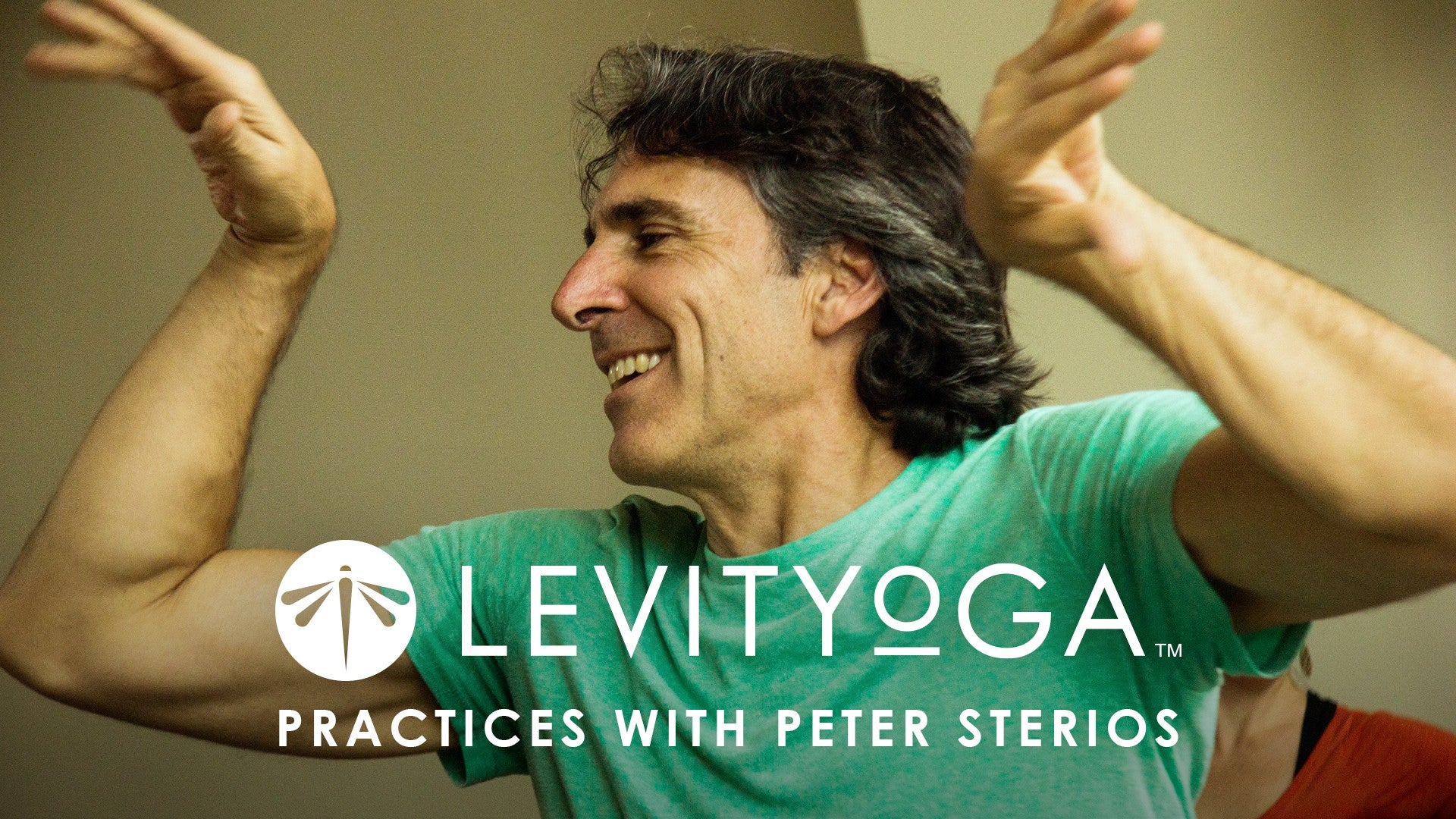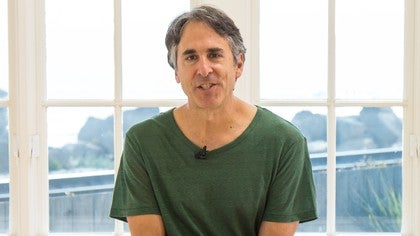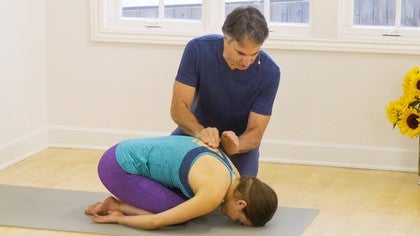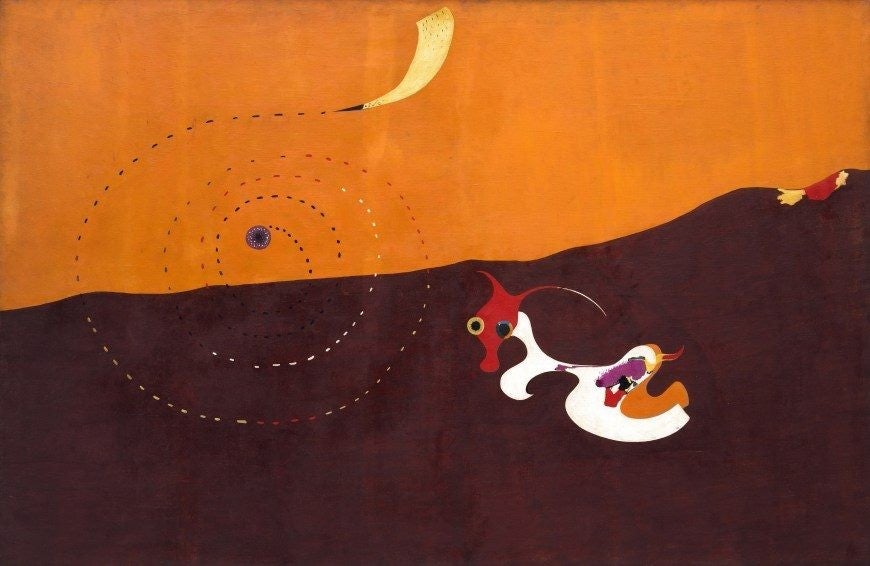Description
About This Video
Transcript
Read Full Transcript
This next practice will balance the masculine and feminine channels in the body through a practice known as pranayama. And one of the most important aspects of this is to make sure that the nasal passages are both balanced. One is more, if one is more open than the other, we want to create balance. And the way we do this is with a pose known as anantasana. So what I want you to do is notice which nostril is more dominant, meaning more open. And if you pay attention you can feel which is more open. The open side you'll lay down on that side. So in this case my left nostril is open and I'm laying down on my left side. Look down the front of your body make sure your legs and your arm are in a straight plane. And then bending your lower arm place the hand supporting the head, balancing on the right side of your body. And you're going to feel a little wobbly here. Then the second part you're going to bend the upper leg and the upper hand grabs the big toe. You're going to slowly straighten that upper leg up. And this is where the balance comes in. Breathe into the lower lungs. And on the exhale soften the lower ribs, lower hip, and soften the lower armpit. So you feel gravity pressing the lower side of your body into the mat. Feel your upper arm hanging from the big toe, breathing through both nostrils. Slowly. Three to four second inhale, three to four second exhale. That upper hip coming forward a little bit. As the hip comes forward the upper leg pulls back a little. And literally you're balancing on the side of your body. Each inhale breathing into the bottom lung. The full length of your torso. Each exhale softening the lower ribs. Feel the weight of your organs drop. Soften through the pelvis. Soften through that right shoulder and armpit. And now keeping the head supported, slide that lower thumb forward blocking the nostril, the lower nostril. And breathe only through the upper nostril. If the nostril is slightly blocked, just slowly breathe. If you need to cheat a little, open your mouth when you need to. And then return back to breathing just through that upper nostril slowly. If you pay attention here as you breathe slowly, you'll start to feel that upper nostril starting to open a little more. You may even feel a little drainage moving down out of the nostril into the back of the throat. As you feel that nostril open and then slowly release and change sides. Extend the arm, straighten the legs. Look down the front of your body again. Make sure the legs, the torso, and the arm are in a straight line. And then supporting the head with the lower arm. Bend the upper leg. Upper hand grabs the big toe with the forefinger and middle finger. Slowly straighten the leg up. Breathe into the lower lungs. On the exhale, soften the lower ribs, hip, shoulder, and armpit. Gravity pressing you into the mat. Feel the upper arm hanging from the big toe, shoulder passive. Top hip coming forward a little, top leg moving back a little. Keep the sound of your breath soft. Again we're moving now the thumb forward, hand supporting the head, thumb blocking the lower nostril. Breathe only through the upper nostril slowly. We don't have to stay as long on this side since that upper nostril was the more dominant nostril initially. And when you're ready, release. Sit in a simple cross-legged position. If you need a little support under your hips, we're going to be sitting here about 10 minutes, you can put it under your hips. If you're comfortable in lotus, sit in full lotus. If you need to, slide your butt cheeks a little wider so you feel heavy in the pelvic floor. Place your left hand on the knee. The right hand, forefinger and middle finger goes to the third eye. Tip of the thumb on the right nostril, ring and pinky on the left nostril. When you want to place the tips of your fingers right where the hard cartilage of the nose meets the soft cartilage of the nose. And you'll notice if you notice my fingers here, I'm not actually lifting my fingers away from the nose. I'm sliding the flesh here starting on this side with the thumb. I'm sliding the flesh of the nose nostril up as I slide the thumb up a little. That flares and opens this right nostril. And then as I switch, the thumb slides down to block it. And on the ring and pinky finger side, I'm also sliding the flesh up, flaring the nostril and opening. And when we begin this first pranayama, which is known as bastrika, this happens quite instantaneously, rapidly. And you'll see, you may want to watch this first and then I'll keep going and you can join. So it'll start with a three-quarter inhale, not completely full, and it'll begin on the right side. Finish on the right side. Wipe the boogers on the back.
Okay, place your hands flat on the floor in front of you, arms straight. Let your head fall forward a little. Inhale slowly through the nose, following the breath through the back into the pelvic floor. Exhale slowly, mouth open, tongue out. When you're empty, hold the breath out, suck the navel in. Release. Again, inhale slowly through the nose, mouth open, tongue out. Exhale. Really push the breath all the way out till you're empty. Release. Last one. Inhale slowly. Mouth open, tongue out. Exhale. And release. Again, right hand, forefinger and middle finger to the third eye, tip of the thumb on the right nostril, ring and pinky on the left. Inhale three-quarters full, and begin on the right. And once again, hands flat on the floor. If you're in lotus and you want to try variation, grab the feet, press the tops of the feet down into the tops of the thigh, shoulders pass it, and let your head fall forward slightly. Inhale slowly through the nose, mouth open, tongue out. Exhale. Release. Again, inhale through the nose.
Mouth open, tongue out. Exhale. Release. Last one. Inhale slowly through the nose. Mouth open, tongue out. Exhale. And release. Left hand returns to the knee. The right hand actually curl the forefinger on this one into the center of the palm, forefinger and middle finger. Then the left hand to the knee, tip of the thumb on the right, ring and pinky on the left. So this next one is known as Nadi Shodhana Pranayama. It's similar to Bastryka, except it's super slow. And we'll do one round together and then two rounds in your own time. So to start, you're going to block the left nostril and slowly inhale through the right.
When you're comfortably full, block the right, open the left, exhale slowly through the left. Keeping the left open, inhale through the left. Blocking the left, open the right, exhale. That completes one round. Now do two more rounds like that in your own time. Nadi Shodhana Pranayama. After the third round, release the hand to the knee. Head upright, eyes closed.
Slow your breath, breathing through both nostrils. Breathe into the front side and back of the lungs, the full length of your torso. Reach exhale, release through the shoulders, chest and belly, organs drop a little. Draw the chin slightly in towards your throat, spine engaged gently from the back of your skull. Now slowly exhale and move your attention to the right nostril.
Inhale right nostril, psychically, cool, expansive energy from the tip of the nostril to the third eye. And then exhaling psychically from the third eye to the left nostril, warm and soft, feeling that sensation move to the tip of the left nostril. Then inhale, cool, expansive from the left nostril, up the linings to the third eye. And then warm, softening from the third eye along the linings of the nostril to the tip of the right nostril. Again, inhale right nostril, cool, expansive to the third eye.
Exhale warm, soft from the third eye to the left nostril. Inhale cool, expansive left nostril to the third eye. Exhale warm, soft from the third eye to the right nostril, tip of the nostril. And now both nostrils inhale cool, expansive, converging on the third eye. Warm softness from the third eye to the tips of both nostrils.
Again, both nostrils cool, expansive from the tips to the third eye. Warm softness from the third eye back to the both nostril tips. And then releasing control of your breath, breathe naturally, witnessing the natural rhythm of your breath. Release through the shoulders, chest, and belly. Keep the spine engaged lightly from the back of the skull.
Each inhale, feeling the breath front, side, and back of the lungs into the pelvic floor. Each exhale, simultaneous drop through the front body and internal organs, lift gently through the back body, chin slightly in toward your throat. So that exhalation cycle, there's a simultaneous drop and extension up through the crown of the head. Feel your abdominal organs heavy in the pelvic floor, sphincter muscles soft. When you're ready, slowly open your eyes.
Keep your gaze soft. And release, slowly straighten your legs. And then just with a soft fist, gently tap the outer legs, especially if they fell asleep. And then the inner legs, then the hips, sacrum, back of the fist on the kidneys, belly, chest and side ribs, top of the shoulder and arm, underarm, armpit, and other side. That ends the Pranayama practice.
Namaste.
LEVITYoga: Deepen Your Practice
Comments
You need to be a subscriber to post a comment.
Please Log In or Create an Account to start your free trial.










 miro
miro



